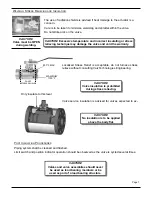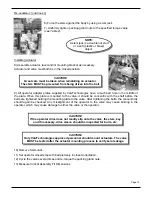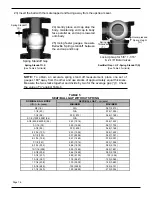
Page 18
TESTING
1) Valves may be tested in accordance with ValvTechnologies’ Quality Procedure, VQP 010.
2) When performing the seat test, the pressure must be applied on the upstream side. The arrow on
the valve (or the label indicating the high pressure end) will indicate the direction in which pressure
should be applied.
NOTE:
Bi-directional valves must be tested with consideration for the required reverse
pressure sealing. Prior to any testing of bi-directional valves, a ValvTechnologies approved
service center should be consulted to gain the correct test procedure and test pressure.
MALFUNCTION
POSSIBLE CAUSE
REMEDIAL ACTION
Valve will not rotate or
operate
1) Actuator has failed
2) Valve packed with debris
3) Stem key has sheared
4) Ball seat gap incorrect
1) Replace or repair actuator
2) Cycle & flush valve to re-
move debris
3) Determine cause of shear-
ing & correct/replace keys
4) Call
Factory
Stem Packing Leaking
1) Gland bolts loose
2) Packing damaged or missing
3) Seal
misaligned
1) Tighten gland bolts
2) Shut down system & re-
place packing
3) Replace & properly align
Body Gasket Leaking
1) Body Bolts loose
2) Body gasket damaged
3) Body gasket seating faces in
body or end piece damaged
1) Tighten body bolts
2) Remove valve from service
& replace body gasket
3) Return parts to ValvTech-
nologies for rework
Valve Ball/Seat Leaking
1) Valve not fully closed
2) Debris trapped in valve
3) Seat or ball damaged
1) Close the valve
2) Cycle & flush to remove
debris.
TROUBLE SHOOTING



































